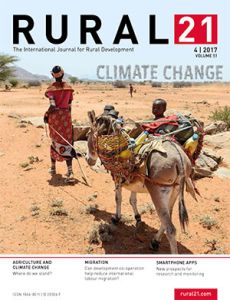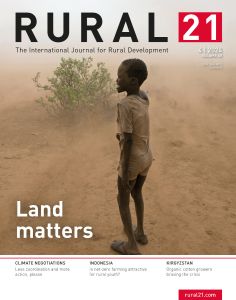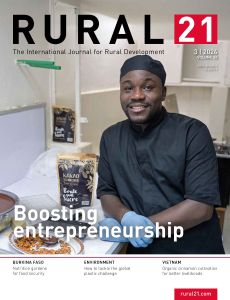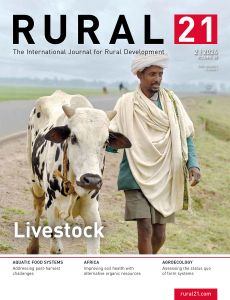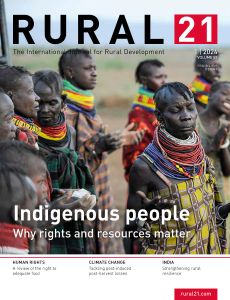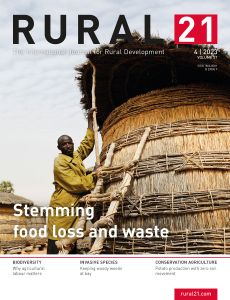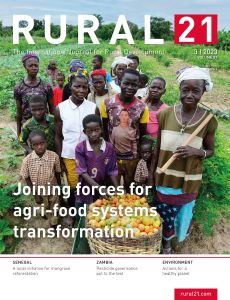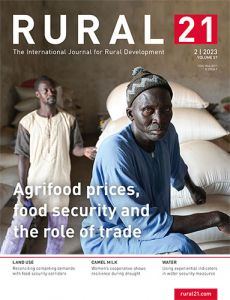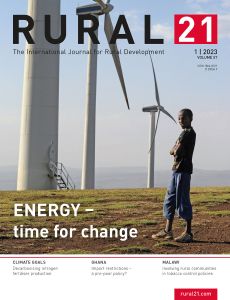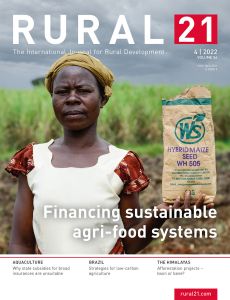Rural 21 (Englische Ausgabe)
-
ABONNEMENT: Rural 21 (englisch)“Rural 21 – The International Journal for Rural Development” widmet sich seit über 50 Jahren den Fragen der ländlichen Entwicklung in Entwicklungs- und Schwellenländern. Neben den 17 Nachhaltigkeitszielen (SDGs) der Vereinten Nationen bis 2030 stehen thematisch Landwirtschaft, Klimawandel, Forstwirtschaft, Nahrungssicherheit, Armutsbekämpfung, Gesundheit und Bildung, natürliche Ressourcen und Umweltschutz im Mittelpunkt. Erfahren Sie mehr
-
Rural 21 (engl. Ausgabe 4/2024)
Focus 4/2024: Land matters
Mid-December 2024, the 16thConference of the Parties to the United Nations Convention to Combat Desertification – UNCCD COP 16 for short – was forming the conclusion of a “triple COP Year” in which three important UN Conventions (UNCCD, UNFCCC and CBD) were negotiated in just three months’ time. What the three COPs have in common is that they need land to implement their targets – land that is scarce and confronted with increasingly competing demands.
Our authors and interview partners show what the impacts of insufficiently considering this interconnectedness in the Rio Conventions are like, and what has to be done to achieve more coherence in putting them into practice on the ground. Here, not only do they clarify the economic benefits of mutual action – for of course the implementation of the Conventions is above all a matter of (scarce) financial resources.
Above all, they refer to practical examples from very different regions throughout the world of how people and the environment can benefit from integrated approaches, so that balancing economic, environmental and social needs can really be achieved. And here, they once again show how important a rights-based approach is which also addresses the needs, experience and expertise of Indigenous Peoples, women and local communities.
Erfahren Sie mehr -
Rural 21 (engl. Ausgabe 3/2024)
Focus 3/2024: Boosting entrepreneurship
Over the last few years, rural entrepreneurship has claimed its stake in the international cooperation agenda – and there are clear reasons for this. Entrepreneurship creates jobs and generates income and wealth; it makes staying in rural areas an attractive proposition for young people and helps them build confidence and status. Rural entrepreneurs can contribute to coping with today’s environmental challenges. They are able to promote the circular economy and assist in safeguarding the environment, thereby adding value to the abundant natural resources of rural areas. This is above all important for those living together with and from nature, such as indigenous communities. And last, but not least, entrepreneurship is regarded as a vital tool for women’s empowerment.
The factors determining whether young enterprises are successful and can hold their own on the market can generally be divided into two categories: the entrepreneurial mindset and various skills of the (future) entrepreneurs themselves, and the framework conditions in which they are acting, such as the legal environment, infrastructure, training possibilities and, above all, access to finance. Social values and norms play a crucial role too, especially when it comes to women entrepreneurs making progress. Referring to their projects, our authors and interview partners show what helps young enterprises in rural areas to become successful, what helped them achieve their own aspirations, and where they see shortcomings.
Erfahren Sie mehr -
Rural 21 (engl. Ausgabe 2/2024)
Focus 2/2024: Livestock
Regarding the transformation of our agricultural and food systems, hardly any sector has been as controversially discussed as livestock farming. In the Global North, quite a few people would like to see animal products entirely deleted from the human diet – because this could reduce the emission of harmful greenhouse gases; because valuable natural resources such as land and water could be used more efficiently; because deforestation to create pastureland could be stemmed, which would protect biodiversity; and because, in many cases, they cannot reconcile animal husbandry with their animal welfare aspirations. Not to mention the rapid growth of malnutrition and nutrition-related illnesses through excessive consumption of animal-sourced food and health risks such as the transmittance of zoonotic diseases.
However, a world without animal agriculture is simply not realistic. The issue here is not just that of producing food such as milk, eggs and meat, which represent an important source of proteins and micronutrients for many people, or of using draught animals for land cultivation. For women in particular, keeping small livestock is often the only option to earn their own income, and is hence key to economic and social empowerment. Animals can serve as forms of saving, insurance and social security. And they are an integral element of the urgently needed agro-ecological transformation, which is also based on the principles of the circular economy and (nutrient) recycling.
By declaring 2024 the International Year of Camelids, the United Nations has been highlighting the importance of these animals – and hence also the importance of the pastoralist way of living – for food security and ecosystem functions. Knowing fully well that sustainable solutions for tomorrow’s livestock systems always need a multi-faceted and context-specific lens, our authors ultimately back livestock farming too.
Erfahren Sie mehr -
Rural 21 (engl. Ausgabe 1/2024)
Focus 1/2024: Indigenous people – why rights and resources matter
Currently, there are around 477 million indigenous people living in roughly 70 countries across the world. They speak more than 4,000 of the world’s 7,000 languages, and they protect roughly 80 per cent of the world’s remaining biodiversity. But while making up slightly more than six per cent of the global population, indigenous people account for about 15 per cent of the extreme poor, and their life expectancy is up to 20 years lower than that of other population groups.
There are many reasons for this. The great majority of indigenous communities live in remote and fragile environments, with very limited access to basic services, including healthcare, water and sanitation, energy and education. Moreover, territories and natural resources which provide livelihoods for a large number of these people are increasingly under threat – not only from the impact of climate change, but also because of the growing demand for foodstuffs and forest products, fuels and valuable minerals. Violations of rights are a regular occurrence.
Our authors – many of whom belong to Indigenous Peoples – demonstrate which international bodies of law indigenous people can refer to and describe the strengths and weaknesses of tools and instruments which have been developed to enhance their access to justice and development. They show the flipside of the green energy transition and give examples of successful advocacy work. And they report how the valorisation of indigenous knowledge can be achieved – including rewarding people for the valuable ecosystem services they provide.
Erfahren Sie mehr -
Rural 21 (engl. Ausgabe 4/2023)
Focus 4/2023: Stemming food loss and waste
According to the latest progress report for the Sustainable Development Goals, about 8 per cent of all food produced in the world is lost on the farm, 14 per cent is lost between the farm gate and the retail sector, and 17 per cent is wasted at the retail, food service provider and household levels.
What is disturbing here is that these figures haven’t changed significantly in the past decade. Roughly 40 per cent of food still doesn’t get where it is meant to go, namely to the stomachs of the consumers. But hasn’t any progress at all been made in terms of food loss and waste? Or don’t we simply have any reliable methods to adequately assess the phenomenon? The answer is that both applies.
A recent study by the UK’s University of Greenwich arrives at the conclusion that food loss and waste measurements are usually aggregated from relatively small samples to national levels. This can result in volumes being considerably under- or overrated. Moreover, while we have a good knowledge of the problem in developed countries, above all of waste, little is known about that phenomenon in low- and middle-income countries. The question arising here is how to tackle a problem which can’t be properly measured.
While keeping these shortcomings in mind, we have asked our authors to present innovative, practical and, above all, scalable solutions from the fields they work in which can contribute to less food being wasted – for global food and nutrition security, for the economy, for the environment and for our climate.
Erfahren Sie mehr -
Rural 21 (engl. Ausgabe 3/2023)
Focus 3/2023: Joining forces for agri-food systems transformation
Our current agricultural and food systems are not capable of providing the global population with sufficient and healthy food within the planetary boundaries. Worse still, with their high freshwater consumption, their greenhouse gas emissions and their representing a threat to biodiversity, they destroy their very own ecological basis. The multiple crises of the last few years have added to all this, with the consequence that Sustainable Development Goal 2 – ending hunger by 2030 – will definitely not be reached.
It is generally agreed that our agricultural and food systems need fundamental changes – towards sustainability, resilience, health, equity and inclusiveness. But how can this best be achieved? Based on the global discourses of the past years and the initiatives emerging from them, our authors have identified key levers and cornerstones for successful agri-food systems transformation.
As can be expected, these vary depending on whether they reflect the view of politics, science or civil society. Nevertheless, consensus has been reached on many issues. The transformation pathways have to be systemic and cross-sectoral, and must break down complexity. They have to be locally owned, context-specific and include all stakeholder groups. They must regard trade-offs as inherent and create an acceptable compensation for the losers. And they have to contain short-, medium- and long-term activities. Based on experience gained in Ethiopia, Kenya, Rwanda and Tanzania, in Chile and Brazil, and in Bangladesh and Vietnam, our authors show what this can look like in practice.
Erfahren Sie mehr -
Rural 21 (engl. Ausgabe 2/2023)
Focus 2/2023: Agrifood prices, food security and the role of trade
Following the Russian Army’s invasion of Ukraine in late February 2022, food prices soared up world-wide in next to no time. Not only did the Food Price Index of the UN Food and Agriculture Organization reach an all-time high, fertiliser and energy prices leapt up across the world, too – with the well-documented consequences for food production and supply in many countries, above all in those of the Global South. That the wheat price has now, some 15 months later, returned to its pre-war level – despite the war’s going on and the Ukrainian grain exports having collapsed – shows that the world markets seem to be more resilient than expected.
In this edition, our authors take a look at the complex relations which – alongside the obvious shocks and crises – are behind price formation on the international agrifood markets. They analyse what triggered the major food price spikes in past years and how the food crises then and today differ from each other. Special attention is given to the role of speculation and the growing corporate concentration in the food chain, be it the seeds, farming machinery, agrochemicals or commodity trade sector.
Historically, there has been a pronounced correlation between international food and fertiliser prices. Our authors show what long-term fertilisation strategies could look like – strategies that make farmers and the economies independent of price developments on the international fertiliser markets and above all enhance the yields and labour productivity of smallholders.
Erfahren Sie mehr -
Rural 21 (engl. Ausgabe 1/2023)
Focus 1/2023: Energy – time for change
In addition to causing anxiety over global food security, Russia’s invasion of Ukraine has put the issue of energy security right at the top of the political agenda. In combination with a fear of supply bottlenecks, the dramatic fossil fuel price hikes have given new impetus to a transition to low-carbon energy sources – which is urgently needed anyway given global warming. In November last year, the International Energy Agency (IEA) announced that overall capacity of renewables is to almost double world-wide in the coming five years. Then these “clean” energy carriers could replace coal as the biggest source of electricity generation. From 2022 to 2027, the IEA is reckoning with power produced from renewable sources amounting to 2,400 gigawatts (GW) – a volume corresponding to China’s total power generating capacity. China, the USA and India are set to be the biggest drivers of renewable energy development, the IEA continues. And they are precisely the countries responsible for the largest shares world-wide of CO2 emissions (China: 33 %; USA: 13 %; India: 7 %). The latest edition takes a look at this change in global energy flows, the challenges which are currently emerging for Africa in particular in the energy sector and the role which the Global North plays in this context.
Erfahren Sie mehr -
Rural 21 (engl. Ausgabe 4/2022)
Focus 4/2022: Financing sustainable agri-food systems
Not only since the UN Food Systems Summit in September 2021 has the urgent need for a transformation of our agri-food systems been beyond question if SDG 2 – ending hunger and malnutrition in all its forms by 2030 – is not to get completely out of reach. However, the current world-wide bleak economic prospects are certainly not making the mobilisation of the resources this essentially requires any easier.
Alongside budget constraints, financial institutions sticking to their old patterns of behaviour are responsible for the urgently needed investments in the sustainable transformation of our agri-food systems having either failed to materialise or not being on target. Wrong incentives, not considering externalities in setting food and agricultural prices, lobbyism and not adequately prioritising the money available are further reasons. This edition shows you the approaches which science and development cooperation, financial institutions and the private sector regard as having proven promising in rebuilding our agri-food systems in line with the Agenda 2030 and making them resilient in the long term.
Erfahren Sie mehr

